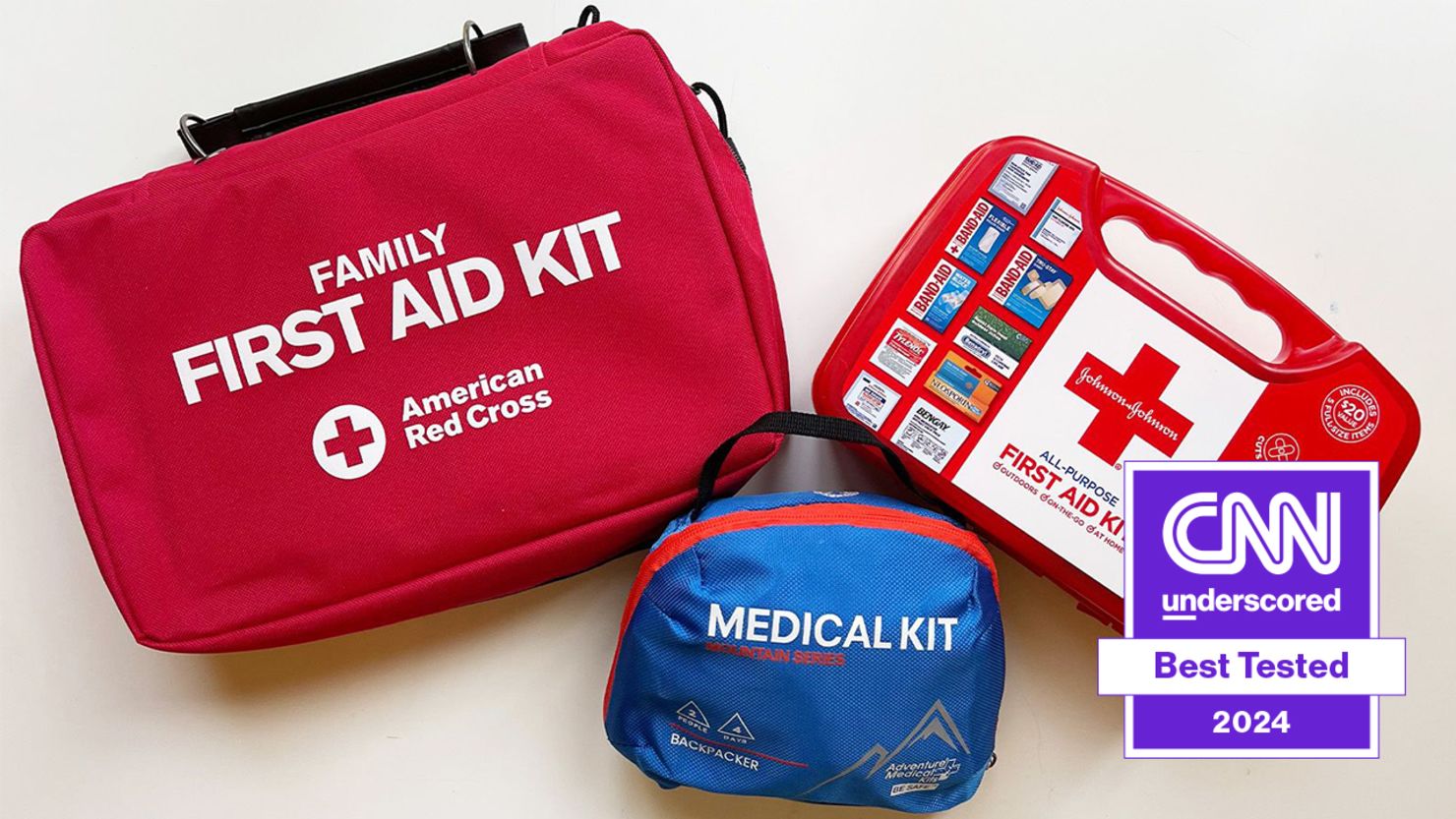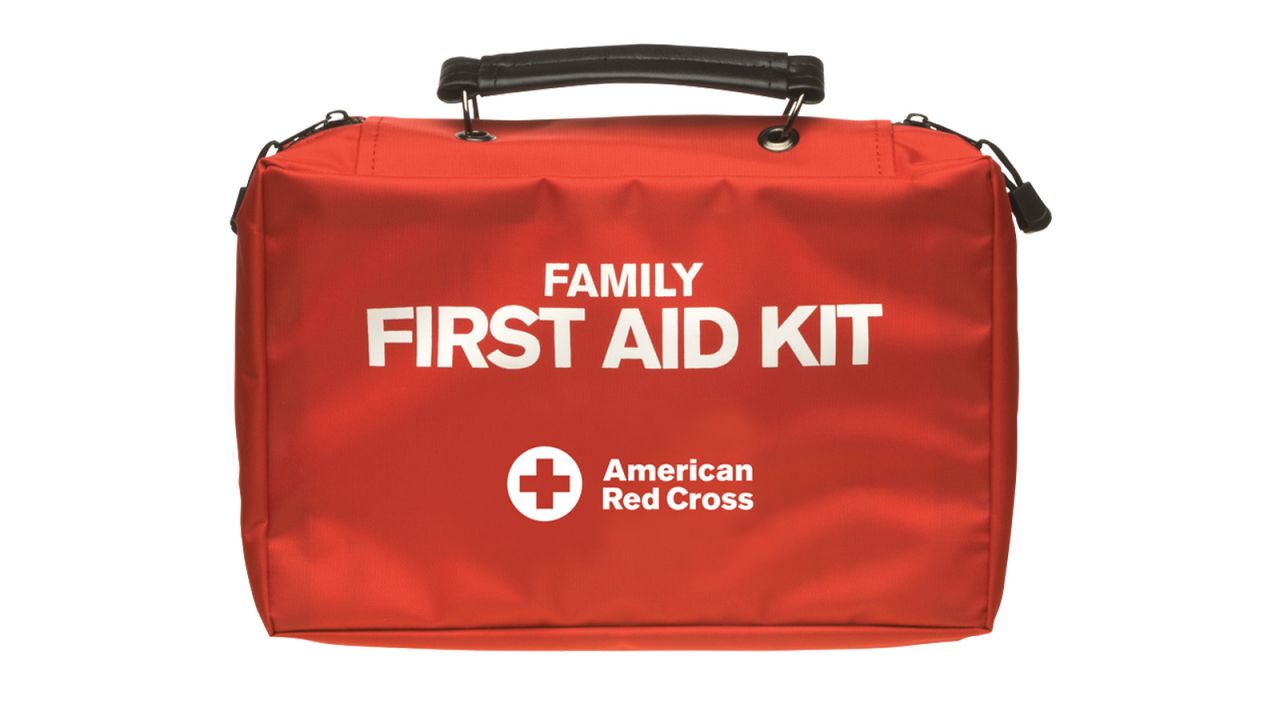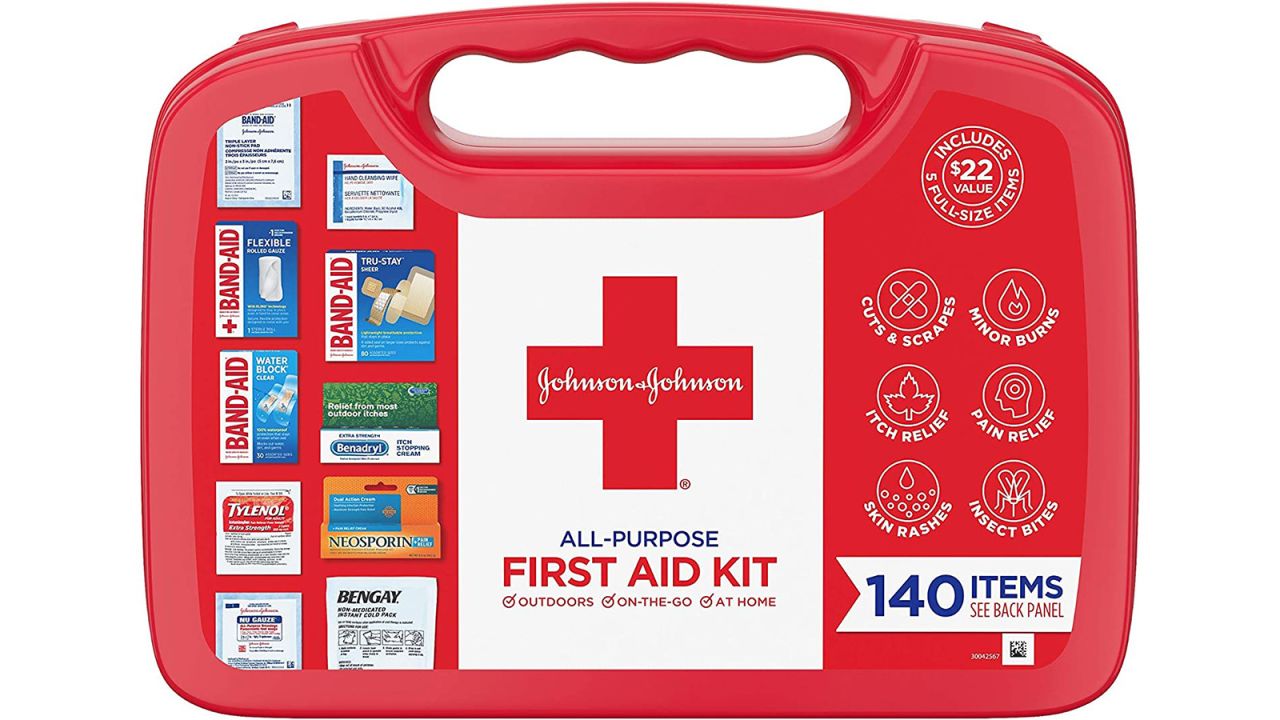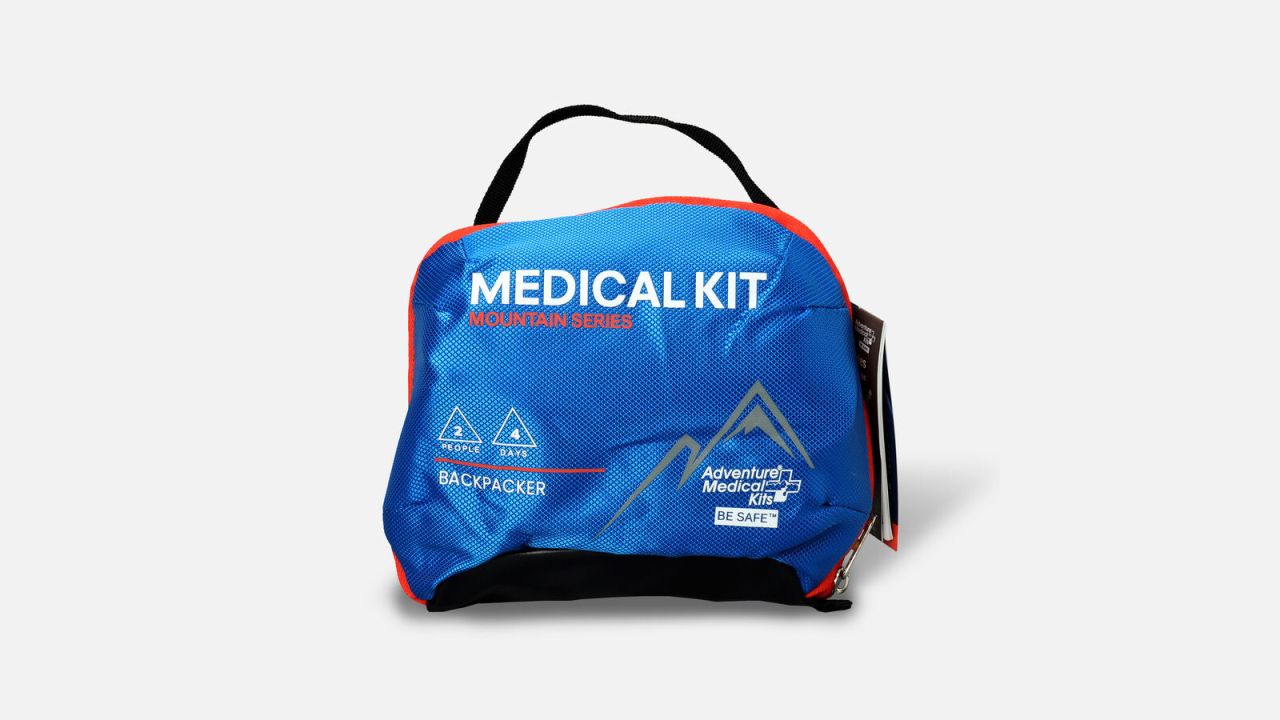The best first aid kits we tested
Best first aid kit: Red Cross Deluxe Family First Aid Kit
Best budget first aid kit: Band-Aid Johnson & Johnson First Aid Kit
Best first aid kit for camping and backpacking: AMK Mountain Series Backpacker Medical Kit
Every home needs a dedicated first aid kit, even if just to organize the supplies scattered around in medicine cabinets, drawers and cupboards, making it much easier to grab them in a stressful situation. Whether you’re dealing with a fire, a weather emergency or just a skinned knee, an organized, complete kit can let you treat minor injuries quickly and effectively — it’s as much of an essential piece of emergency gear as a flashlight, solar generator or emergency radio.
To find the best first aid kits to keep in your home, car or with you while traveling, we tested 17 popular kits, ranging from pocket-size containers to backpacks full of survival gear. We also consulted with experts at the Red Cross to best understand how to choose the right first aid kit for any situation.
An easy-to-use ring-binder-style design, high-quality products and all the essentials recommended by the Red Cross means the Red Cross Deluxe Family First Aid Kit will give you everything you need.
Don’t let the rock-bottom price of the Band-Aid Johnson & Johnson First Aid Kit fool you; it provides a useful collection of name-brand items packed securely in an easy-to-transport case.
In addition to basic supplies for household use, the AMK Mountain Series Backpacker Medical Kit is lightweight, prioritizes organization and includes several items specifically for treating common hiking, backpacking and camping issues.
Best first aid kit: Red Cross Deluxe Family First Aid Kit
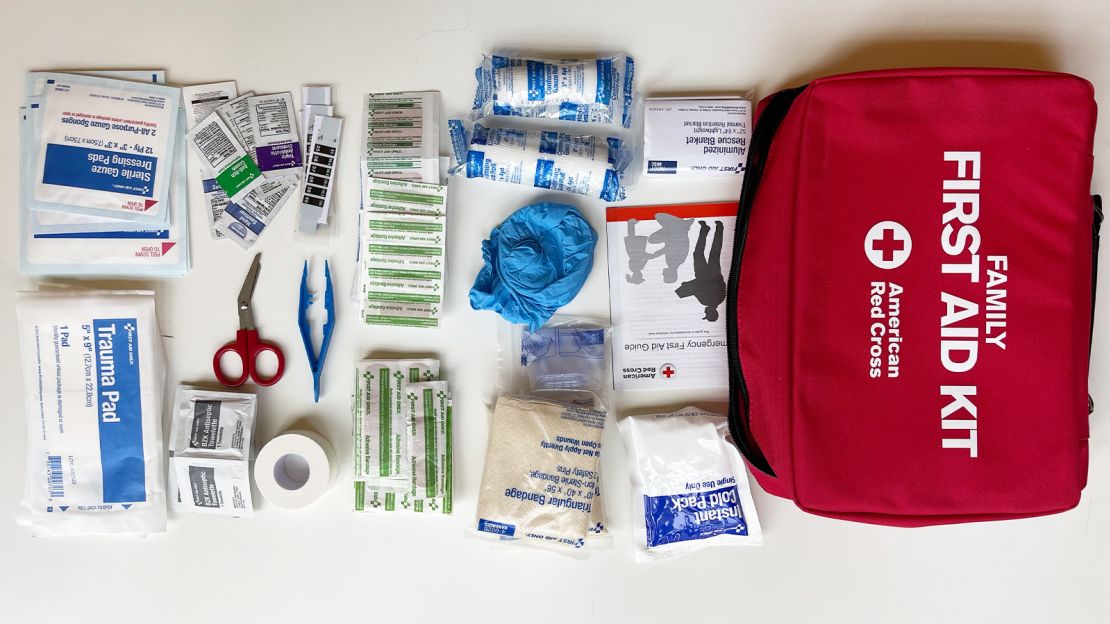
With a heavy-duty case and a variety of high-quality items inside, the Red Cross Deluxe Family First Aid Kit was a no-brainer as our top pick. Right out of the box we noticed how rugged and well made the case itself felt, complemented by metal grommets and sturdy zipper pulls. A wide handle also made it convenient for carrying around the house during our testing. We’re also big fans of the bright red color, which makes it easy to spot in a cluttered car trunk or backpack.
What really sets this kit apart from the other models we tested was its ring-binder-style design. Once unzipped, the contents are displayed in clear vinyl pockets that you simply flip through to find the item you want. This design also allows it to lay flat like a book while you use it, and the extra-large sleeve pouches at the front and back of the kit are large enough to store other emergency documents, such as allergy issues or specific medical issues of a family member. When it comes to clear organization and finding first aid items quickly and easily in an emergency, it really doesn’t get much easier than this.
Its focus on providing clear and concise first aid instructions and information was the other factor that separated this kit from the rest of the pack. In addition to a manual that includes straightforward instructions on dealing with common medical emergencies like choking, stroke, seizures and cardiac issues, the kit also includes several extra-large info sheets. These sheets are presented in large clear pockets on the left-hand side, with their corresponding first aid items on the right-hand side as you flip through.
This kit was also only one of?three other kits we tested that provided all of the essential items recommended by our Red Cross expert, Jeffrey L. Pellegrino. It also included two pairs of non-latex exam gloves, which, as the Red Cross explains, will allow you to change gloves if needed, or allow a second responder to help out at the same time. We were also impressed with the overall quality of the 115 pieces inside. The 1-inch-by-10-yard tape roll was a particular standout, and along with the bandages and dressings, held up really well during hands-on testing. Although the scissors were relatively small compared to the EMT-style shears found in other kits, they had no trouble cutting through the tape or trimming gauze.
The durability, usability and variety provided by this kit make it just as useful in your cupboard as a go-to home first aid kit as it would in the trunk of your car or backpack on a camping trip.
Best budget-friendly first aid kit: Band-Aid Johnson & Johnson First Aid Kit
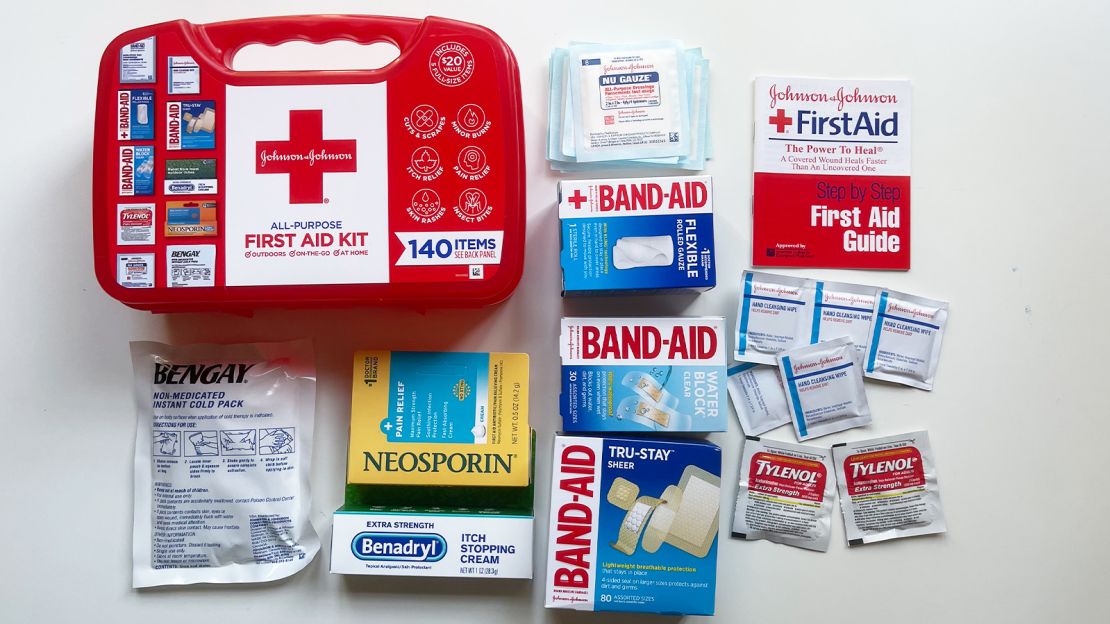
While the Band-Aid Johnson & Johnson First Aid Kit doesn’t have the quantity or variety of most other options, its rock-bottom price makes it a great choice for those on a budget. We’re honestly not even sure exactly how this kit can be priced this low, considering the bandages alone are worth almost 75% of the cost of the entire kit, and it still provides eight other products!?A durable plastic case ensures that everything stays safely inside, and the oversized handle makes it convenient to carry around from place to place.
Even though there aren’t any spacers or really any organizational elements to this kit (it’s essentially a big lunch box), it was actually easier to find what we wanted than many other kits. Since nearly every item is included in its own separate box, there aren’t a hundred small pieces floating around needing to be organized into sleeves or pouches. When you’re finished with the bandages, or Neosporin, or gauze, you simply put the rest back in its box and toss it back in the kit.
All of the bandages performed really well in our testing, especially the “Water Block” Band-Aids that stayed put even after washing the dishes. The included Red Cross manual is a great resource and covers a wide range of emergency situations as well as the necessary steps to treat them effectively.
We’d like to be clear that this kit does not include all the essentials recommended by the Red Cross, such as gloves or a CPR face shield. It also lacks a pair of tweezers, so you’ll probably want to add those separately. That being said, the pieces that this kit does include are well thought out and all high-quality name-brand products, making this a really practical kit to have on hand for common first aid situations.
Best first aid kit for camping and backpacking: AMK Mountain Series Backpacker Medical Kit
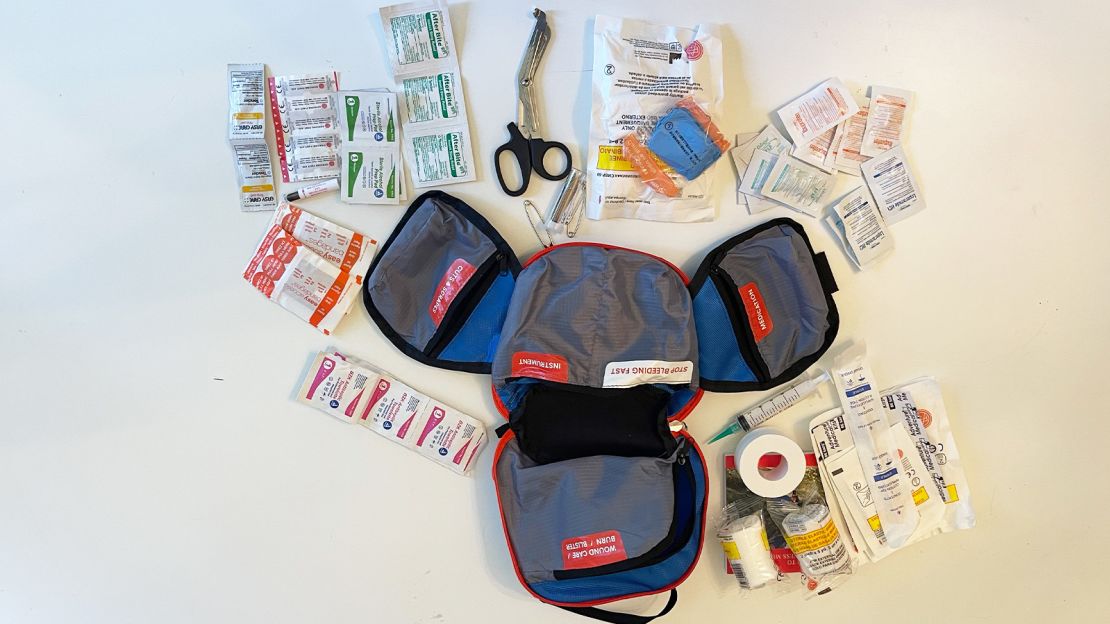
What makes the AMK Mountain Series Backpacker Medical Kit so great is that, even though it’s designed to be convenient and functional for backpacking and hiking, it’s also versatile enough to be used in your home or stashed in your car for emergencies. Except for a CPR face mask, it provides everything recommended by our Red Cross expert, along with an impressive variety of bandages, including knuckle and butterfly options.
Our favorite aspect of this kit is its unique design, which unzips to reveal four distinct storage pouches, each labeled with the general purpose of the contents inside. This organizational layout could come in extremely handy when out on a trail or campsite, where you don’t have a convenient surface to unload your kit and find what you need. The semitransparent material helps even more, giving you an idea of what’s inside each pouch before you even unzip it. A fabric handle on top even allows you to hang it from a branch while you work, making things even easier.
What makes this kit specifically useful for outdoor adventurers, in addition to the well-organized design, are the items most useful for those who may not have immediate access to a pharmacy or health care facilities. Things like insect bite wipes, Diamode tablets for treating diarrhea, moleskin for blisters and a large plastic syringe for irrigating wounds are not always found in all first aid kits. A pair of heavy-duty EMT-style shears — as opposed to cheaper, flimsy scissors — could also come in handy for cutting moleskin, or clothes to help make a tourniquet or splint.
Another great feature of this kit that was also included in the other two AMK kits we tested is the first aid manual. This “Guide to Wilderness Medicine” was by far the most comprehensive and helpful manual we found in our testing, and with so much information, it would be invaluable if you found yourself in an emergency situation while away from roads or the ability to call for help.
How we tested
Most first aid kits appear to be fairly similar, which makes it tough to confidently choose the best one. Although we’re not licensed first responders, we did our best to evaluate and compare each kit by using criteria based on our research and from interviews with experts in the field as well as hands-on testing of each kit’s components. We used these results to select our top choices, and to understand the pros and cons of the rest of our testing pool.
Expert insight
- We interviewed and consulted with several experts in the first aid field, including Dr. Pellegrino, who helped inform us about the essential items that should be included in a first aid kit as well as other factors to keep in mind when choosing one.
- We cross-checked each of our kits with his recommendations, noting which items were missing or of poor quality.
Ease of use
- Proper ease of use is essential when it comes to first aid kits, allowing you to use it effectively and efficiently.
- We evaluated how convenient and straightforward each first aid kit was to use, noting how easy they were to open, find what you want, repack when finished and close back up.
Kit organization
- Being able to find items quickly is essential in an emergency, so your kit must be well organized.
- The easier it is to repack everything when you’re finished will also save you hassle and headache when it’s time to use the kit next time.
- After opening each kit, we went through its compartments, pockets, sleeves and other organizational elements, taking note of how easy it was to locate individual items and how thought out the overall design layout was.
Durability
- A first aid kit should be durable enough to withstand a moderate amount of wear and tear without ripping, cracking or coming apart.
- While using each kit, we paid close attention to their overall sturdiness and durability when it came to straps, clasps, zippers and closures.
Hands-on testing
- We opened up each kit and did as much hands-on testing as possible with their contents, assessing the quality of the included items.
- This included applying bandages and tape to our hands and arms and noting how well their adhesive performed, testing any single-use thermometers, tearing open antiseptic wipes to make sure they weren’t dried out and pulling on any examination gloves or masks.
- We paid close attention to the build quality and material of any tools or instruments, such as tweezers and scissors, which had a broader range in quality than we expected.
- While some kits provided high-quality EMT shears and metal tweezers, others used cheap, flimsy scissors and plastic tweezers.
Why do I need a first aid kit?
You need a first aid kit because it keeps all your medical supplies together in one place, so if an emergency does occur, you’ll be able to act quickly. If you or a family member needs first aid, you aren’t going to feel like hunting around your house looking for bandages in the bathroom drawer, your desk for a pair of scissors, the medicine cabinet for antibiotic ointment, etc. A first aid kit is also portable, so if someone crashes their bike in the driveway or suffers a campfire burn in the backyard, you can simply grab the kit and be confident that you have everything you need.
If you’re out of your house on a hike, camping trip, soccer practice or scout outing, then a first aid kit is even more important. Even relatively minor injuries can become serious issues if you have to wait until you reach a hospital or civilization to get treatment. This will also prevent you from having to improvise with unsanitary or inappropriate items that aren’t meant for treatment. A sterile bandage is going to be a lot more effective in the long run than a dirty handkerchief or sweaty t-shirt.
A first aid kit is also an important piece of an effective emergency or disaster kit, which is a larger, more comprehensive kit meant to prepare you for a weather or natural disaster. In this case, you may not have access to a hospital or ambulance for some time, making an effective first aid kit even more important to have on hand.
What should be in your first aid kit?
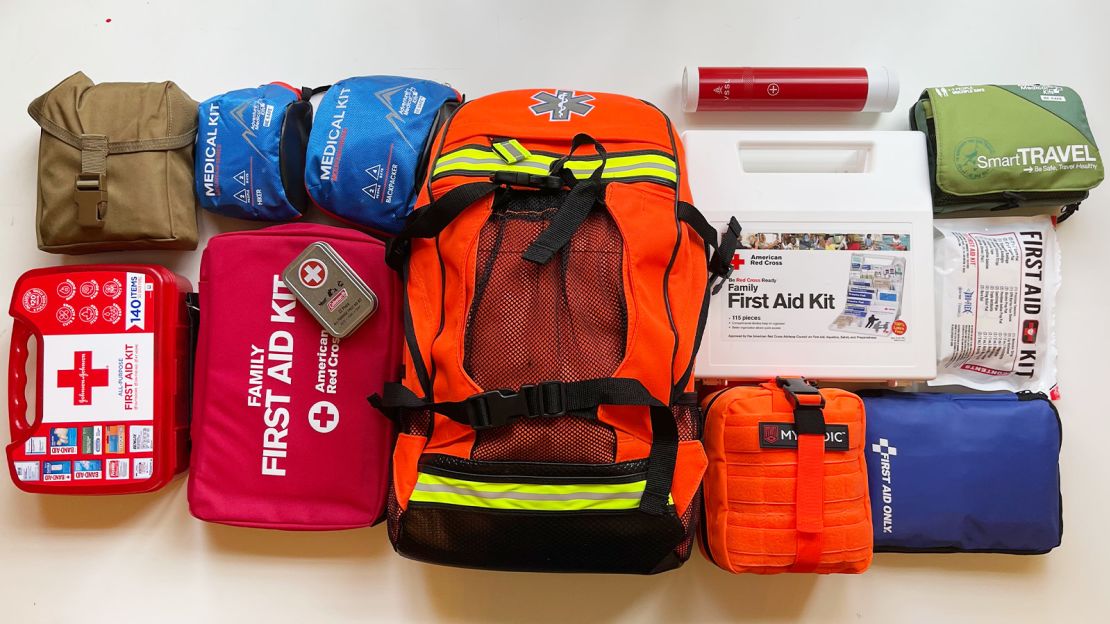
A first aid kit should contain everything you need to treat a variety of common first aid ailments and injuries. Unfortunately, there are a ton of first aid kits on the market, and all of them seem to have a different idea of what exactly should go inside. To help simplify things, we consulted with Dr. Jeffrey L. Pellegrino, senior advisor to the American Red Cross Scientific Advisory Council and professor of emergency management and homeland security at the University of Akron. He shared five essential items you should make sure are in your first aid kit:
- First aid guidebook
- Triple antibiotic ointment
- Non-latex gloves
- A breathing barrier to prevent transmission of disease while performing rescue breaths
- An assortment of self-adhesive bandages, gauze, roller bandages and adhesive tape
It’s worth noting that, just because a first aid kit doesn’t include all these items, it doesn’t mean you should automatically write it off as inferior. If it’s missing one or two components, then feel free to purchase them separately. Dr. Pellegrino made sure to add that for a kit specifically for children “include any lifesaving medications (epinephrine, inhalers, etc.) that a child might need.”
Dr. Pellegrino recommends asking yourself the following questions to help determine the best kit for you:
- How many people does the kit need to serve? (A kit for seven people on a kayaking trip needs to be larger than one for a few family members at home.)
- What are the types of injuries you can expect? (You’ll want to be prepared for more serious injuries on a camping or backpacking trip than a day at the amusement park.)
- What else do you have to work with? (If you have other supplies to work and improvise with, you can keep the size and weight of your first aid kit down.)
- Where will it be stored? (Pellegrino explains that first aid kits and their contents are susceptible to the environment, “so where and how you store it is important to it being useful.”)
Other first aid kits we tested
If you’re looking for a kit that’s more focused on treating serious, traumatic injuries, then the Doom & Bloom Ultimate Compact Grab N’ Go First Aid Kit is probably the option for you.
This kit includes several emergency items that weren’t found in any other kit, including a heavy-duty elastic tourniquet, an Israeli compression bandage and blood-clotting granules. What I liked about this kit is that, in addition to a basic first aid and CPR manual, it also includes a large instructional sheet that walks you through the steps to treat and control severe bleeding injuries. This sheet uses large images and short, straightforward instructions, which is exactly what you want when your adrenaline is pumping and you don’t have time to carefully flip through an entire book. Even the tourniquet has easy-to-follow instructions printed directly on it, clearly indicating how tight to apply it.
The quality of all the items in this pack were all legitimate, name-brand products too, unlike some obscure or knockoff items I’ve seen in lower-quality kits. The high price, relatively small amount of light-duty bandages and lack of a CPR face mask ultimately kept this kit out of our top spot, but if those aren’t a deal breaker for you, this is a fantastic kit.
The relatively bulky size of the American Red Cross Family First Aid Kit isn’t the most convenient for those with limited space or those who plan on stashing their kit in their backpack or glove box, but its variety of essential items makes it a good basic option to have on hand at home or a job site.
The most valuable feature of this kit is the fact that it includes all of the items recommended by the Red Cross, which was only the case in two other kits we tested. It also has a nice supply of bandage types and sizes as well as extra-large sterile trauma pads and conforming gauze rolls, essential for minimizing blood loss during serious emergencies. A pair of triangular bandages and safety pins are also convenient for making a makeshift sling.
Two pairs of gloves were a nice perk as well, as most kits provide only a single set. We were surprised to see that the only medication provided in this kit was a single aspirin packet, whereas almost every other kit provided at least an additional supply of ibuprofen or acetaminophen. The case itself didn’t feel especially durable, though, and I nearly snapped off a hinge clip the first time I tried to open it.
Even though the ITS First Aid Kit is essentially just a large, heavy-duty Ziploc bag, I still found it convenient to use (plus, this makes the entire kit completely waterproof).
This kit hits the sweet spot of just enough items to be useful, but not so much that it’s hard to find what you want. A smaller, resealable bag inside helps to store the smaller items, and even if you need to dump out of the contents to locate a specific item, it’s not a big deal to just toss everything back in. It offers a good selection of useful items like burn gels, anti-diarrhea tablets (very valuable if needed on a hike or camping), electrolyte tablets and sting relief pads. We would have liked a little variety in the bandage selection, though, like butterfly or knuckle options.
We also appreciated the inclusion of a small sheet of moleskin, but since it’s not precut and there are no scissors included in the kit, you’re going to have a tough time applying it. We also wish the plastic tweezers were metal, although this may have something to do with preventing accidentally puncturing the storage bag itself. Although this kit doesn’t include a first aid manual, it does provide a CPR face shield with detailed CPR instructions printed on it, which is a big plus.
The compact sibling of the AMK Mountain Backpacker Medical Kit, the AMK Mountain Hiker Medical Kit is just as easy to use and has almost as much convenient, hiker-friendly functionality.
Once unzipped, this kit folds open to reveal three separate organization pouches, each labeled with the basic use of the items inside: “Wound Care/Burn/Blister,” “Medication,” “Cuts & Scrapes” and “Stop Bleeding Fast,” which contains a large trauma pad and rubber gloves. To make things even easier, the specific contents of each of these pouches are printed on the back of the kit, so you can locate what you want before you even unzip it.
The comprehensive “Guide to Wilderness Medicine” is a great resource to have on hand while out adventuring, and covers helpful first aid situations like fishhook removal, diabetic emergencies, lightning injuries and altitude illness. In addition to a nice variety of quality bandages, precut moleskin patches and gauze pads, this kit features a nice pair of EMT-style shears and compact metal tweezers. It does lack a CPR face shield, though, so keep that in mind.
The compact Coleman All-Purpose Mini First Aid Kit is small enough to fit practically anywhere — it’s about the size of an Altoids tin — and with just 27 items inside, it’s easy to dump out and pick out what you want without much hassle.
Despite the limited number of pieces, this kit still provides an impressive variety of bandages, such as butterfly, knuckle and spot options, as well as antibiotic ointment. I also appreciated the included razor blade, which in the absence of a pair of scissors could be useful for carefully cutting through clothing or stripping cloth to make a tourniquet.
Considering the extremely low price, there’s no reason not to grab a couple of these to toss into your tackle box, glove box or backpack, but you’ll still need to purchase a full-size kit if you want to be prepared for a wide range of first aid situations.
If you’re planning on traveling abroad and want to bring along a first aid kit, then the AMK Smart Travel kit would be a great choice.
My absolute favorite part of this kit is its visual indicator diagrams, which allow you to quickly and accurately explain the details of a first aid situation to others, even if you don’t speak the same language. With the addition of its handy pencil and paper, these visual aids can help you transcend any language barriers. I’ve personally struggled to explain the state of an injured hiker up the trail to a native speaker, and tools like these would have made the situation much easier.
The kit itself is also convenient to use, and the transparent sleeves make it easy to find what you’re looking for. It includes a great first aid manual — just like the other AMK kits — and the contents include a nice mix of bandage sizes and styles as well as moleskin for blister treatment. It doesn’t include a CPR breathing barrier, and it curiously lacks a pair of scissors, although that does make it more convenient for air travel.
Looking for a first aid kit that’s a little more functional? The VSSL First Aid kit is stored in a metal tube that doubles as an extremely bright LED flashlight on one end and a compass on the other.
A rolled-up sleeve inside contains the first aid items, and when unrolled, it showcases everything in transparent mesh pockets. Unfortunately, unscrewing the end caps and pulling out the sleeve isn’t the most convenient, and it takes some time to accomplish. It’s a tight fit inside the tube too, so reinserting takes a little finesse. That being said, the supplies themselves were of good quality, especially the 3M brand Steri-Strips, which we’ve found to be extremely useful for closing longer cuts that bandages struggle with.
This kit didn’t include a pair of scissors, but the compact metal tweezers were nice quality and should hold up well. The disposable thermometers were a nice perk, although I did find them to be 2 degrees lower than my actual temperature when compared to the result from my home thermometer. The 45-piece total is relatively low compared to the other options on our list, so it won’t be practical to cover the needs of more than a couple of people. It is completely waterproof, though, which could be a valuable selling point for a kayaker or river rafter.
The Lightning X First Responder EMT/EMS Backpack kit probably isn’t for the inexperienced, but if you have the proper training and are confident using professional medical instruments, it could be a good fit.
By including advanced medical supplies like a stethoscope, a blood pressure cuff and a range of oral airway sizes, the items in this kit can be used to monitor and treat serious first aid events, as long as you know how to use them. If you’re not specifically trained in these instruments, you could end up doing more harm than good if you attempt to use them during an emergency. The relatively brief first aid manual makes it even more important that a trained responder use this kit.
We were most impressed with the sturdiness and organization-friendly design of the backpack itself, which features a mind-boggling amount of compartments, pockets, pouches, sleeves and elastic straps. Many of these are located on the exterior of the bag too, allowing you to store your most used or time-sensitive items within easy reach. The high quantity of items included, in addition to the professional instruments and useful tools like EMT shears, forceps and a penlight for concussion diagnosis, make this kit a practical choice to have on hand at an event like a sports camp or scout trip.
If you’re interested in a high-end kit that’s designed with durability and variety in mind, this could be exactly what you’re looking for, though it comes at a price.
Right out of the box, I could tell that the bag itself was extremely durable, and the clips, Velcro and zippers felt sturdy and secure as well. You can throw this thing around without worrying too much about damaging it. Inside, the kit opens into two large compartments, each with its own collection of pockets, sleeves and elastic bands, containing a huge amount of gear. In addition to a great variety and quantity of bandages, gauze pads and tape, it also includes a pair of EMT-style shears — the best quality of all the options I tested — a battery-powered thermometer and a penlight with a handy chart printed on the side for comparing dilated pupils.
Items like a finger splint, burn creams and a large Burnshield trauma dressing make this kit especially well-suited for camping excursions. All this gear is packed in separate baggies for specific injuries and treatments, making it relatively easy to keep things organized. That said, some items are hidden in hard-to-find compartments, and if what you’re looking for isn’t in plain view, you may need to take most of the kit apart until you find it. It’s also a challenge to repack, especially if you forget where everything goes.
This zippered kit is simple to open and use, and it contains a surprisingly large quantity of items, most notably the 187 individual adhesive bandages in a range of sizes.
The clear plastic pockets made it easy to see a lot of items at once, although anything stored in the rear sleeves will need a little more digging to access. Considering the low price, you get a good bang for your buck with this kit and its nearly 300 total items. In addition to the basics, it also includes several useful items not always found in kits in this price range, such as sting relief pads, tongue depressors that can be used as finger splints and disposable thermometers.
We do wish the 1/2-inch tape rolls were a little wider, but they still provided a decent amount of security during my testing. The small pair of scissors felt pretty cheap and flimsy as well, but in their defense, they did cut through the moleskin sheets and tape during my testing fairly easily. This kit included all the Red Cross essentials except for the CPR breathing barrier, so you’ll need to purchase one separately if that’s a priority.
Although the quantity and variety of items are certainly useful to have on hand, this kit isn’t the easiest to find what you’re looking for and lacks the user-friendly pockets and pouches found in most soft-sided kits. The lack of a physical first aid manual (a downloadable QR code is included) ultimately kept this out of a top spot.
This kit’s hard-sided case not only protects its contents from getting crushed, damaged, or accidentally spilled, but it’s also completely waterproof. Thick latches keep the lid securely closed when not in use, and the rubber-gripped handle is comfortable to carry and transport. I also appreciated the functionality of this kit, which includes almost everything recommended by our Red Cross expert, as well as a wide variety of other useful items. You’re getting tools like chest seals and a nasopharyngeal airway (NPS) to handle severe first aid incidents, and less intensive stuff like sunscreen, chafing lubricant, and lip balm for everyday ailments.
Just like the other My Medic kit I tested, I was also impressed with the overall quality of the items, like nice and sturdy EMT shears, a heavy-duty tourniquet, and “superskin” cloth bandages that are easy to apply and maintain a strong hold on your skin throughout the day. A pair of ZZips (sort of a zip-tie-style bandage that pulls the side of a laceration together), Skin Glue, and 6 “super strips” (ultra-adhesive tape strips), also make this kit particularly suited to handle wound closure tasks.
The material of the kit itself feels nice and sturdy, but unfortunately, the zipper on my sample unit failed several times, splitting and requiring frequent re-zips to close properly.
We’re big fans of Adventure Medical Kits, and this Sportsman Series model is a great example of their dedication to user-friendly organization. It unzips and unfolds to reveal 3 separate compartments – each for a different type of ailment – and with a transparent window for easy identification. In addition to the basics, this kit also includes a nice variety of bandage sizes and types, and the large syringe is especially useful for flushing out wounds before treatment.
The included “Guide to Wilderness Medicine” is an informative and concise first aid manual, and the user-friendly contents section quickly directs you to your desired section (always a plus in an emergency). Despite the large quantity of items (it claims to be suitable for 10 people for 14 days) it weighs just a hair over 2 pounds, making it a great choice for hikers and backpackers.
The compact size and light weight of this kit (less than 7 ounces) make it especially portable, and built-in loops on either side of the outer bag are perfect for attaching to a backpack with a carabiner clip. However, there are no organizational compartments, making it less convenient to find what you want without dumping it out.
This bare-bones kit doesn’t have the functionality of some of the larger options I tested, but the waterproof design is useful for outdoor excursions or watersports. The Ziploc-style bag is stored inside a watertight nylon bag (with a rubber zipper cover) offering dual protection against moisture ingress. Although it lacks a first aid manual, shears, and an emergency blanket, the items it does include are of high quality, such as a variety of fabric bandages, sterile dressings, and a sheet of pre-cut moleskin. A small roll of duct tape and three safety pins are also handy for basic repair tasks on gear or clothing. Unfortunately, the kit I received did not include the irrigation syringe as advertised, making it slightly less functional than I had hoped.
Although this kit lacks some of the more severe injury treatment tools like a splint or tourniquet, I was impressed with its less common items like splinter probes, saline wash, and eye pads. I’m also a big fan of the empty sections intended for personal use.
Recommended for vehicle use, this Survival brand kit is beefy enough to store larger items, while still compact enough to fit in your trunk without taking up too much space. Its thick exterior is also rugged enough to toss around without worrying about its durability too much. What sets this kit apart from similar options is its dedication to clear and straightforward organization. Unlike some kits that require you to dig around for your desired item – or dump the entire kit out if you’re in a hurry – this one goes almost over the top with its labeling system, letting you know exactly where each tool or medication is located.
My favorite feature of the Survival Vehicle First Aid Kit is the removable CPR card placed on its exterior, which walks you through the required steps without even needing to unzip the case. A second CPR kit on the inside (also clearly labeled) provides a resuscitation shield for safer rescue breaths.
